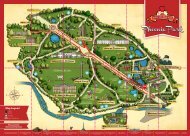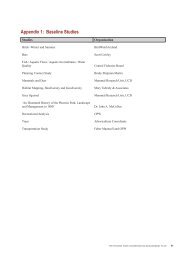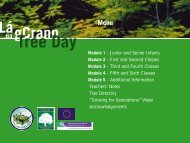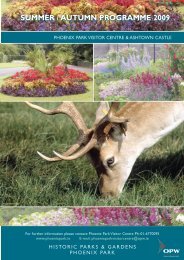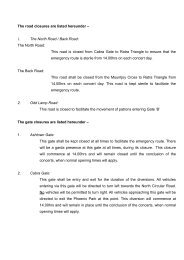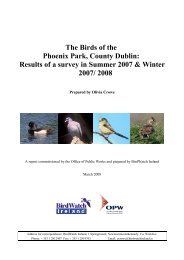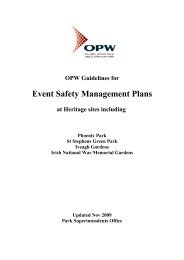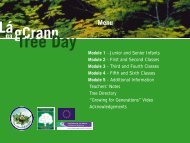Worksheets for 5th & 6th Class - Phoenix Park
Worksheets for 5th & 6th Class - Phoenix Park
Worksheets for 5th & 6th Class - Phoenix Park
You also want an ePaper? Increase the reach of your titles
YUMPU automatically turns print PDFs into web optimized ePapers that Google loves.
Competing and Adapting<br />
Plants and animals have to adapt to compete <strong>for</strong> food and light.<br />
✱ All plants in a woodland need light to grow. Trees compete <strong>for</strong> light and the<br />
tallest trees get the most. So the fastest growing trees do best.<br />
✱ Some plants are specially suited to growing in a woodland. They are adapted<br />
to make the most of the light they get.<br />
✱ Ground flowers, such as primroses and bluebells, flower early in the year<br />
be<strong>for</strong>e the leaves come on the trees. More light gets through to the woodland<br />
floor at this time and there is enough light <strong>for</strong> these plants to flower.<br />
✱ Some plants are adapted to climb up towards the light using<br />
other plants as props. They then have light all the year and<br />
do not have to flower as early. Honeysuckle, which flowers<br />
in August and ivy, which flowers in November, are examples<br />
of these plants.<br />
✱ Animals also compete and adapt in a woodland.<br />
Herbivores that feed on leaves cannot move very fast<br />
to escape from their enemies. They use camouflage –<br />
being the same colour as their food – to hide from their<br />
enemies and they stay very still. Some caterpillars are green<br />
and can’t be seen easily on green leaves. Other caterpillars are brown<br />
and look like twigs.<br />
Some butterflies have eye spots on their wings which birds peck, thinking<br />
they are eyes, and the butterfly escapes with just a hole in its wing.<br />
Some animals have an unpleasant taste so they don’t need to<br />
hide. Ladybirds are red to warn birds not to eat them as<br />
they contain acid. Bees and wasps have stings which<br />
make them dangerous to eat. Their yellow and black<br />
colours also warn off birds. Hoverflies are the same colours as bees and<br />
Wasp<br />
wasps. Although they do not have stings, birds are afraid to eat them.<br />
✱ Many woodland animals feed at night. Snails and slugs feed at night<br />
because they would get dried up in the heat of the sun during the day.<br />
Beetles and spiders hunt at night so they won’t be seen by birds. Bats<br />
Hoverfly<br />
catch moths in woodlands at night. They have developed a sonar system<br />
which allows them to fly and locate their prey without crashing into trees.<br />
Like owls, bats are able to see in very dim light.<br />
To Do<br />
What is a sonar system? Can you find out?<br />
(Clue: sound waves – very high pitch.)<br />
What is an echo?<br />
Discuss ‘as blind as a bat’.<br />
Is it likely that bats would fly into people’s hair?<br />
Trees –Module Four – Worksheet 16




